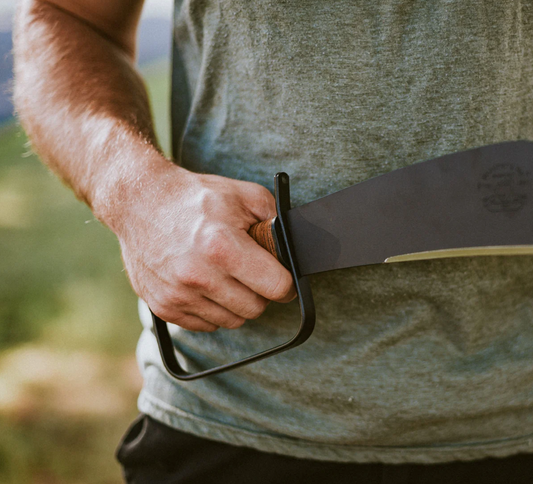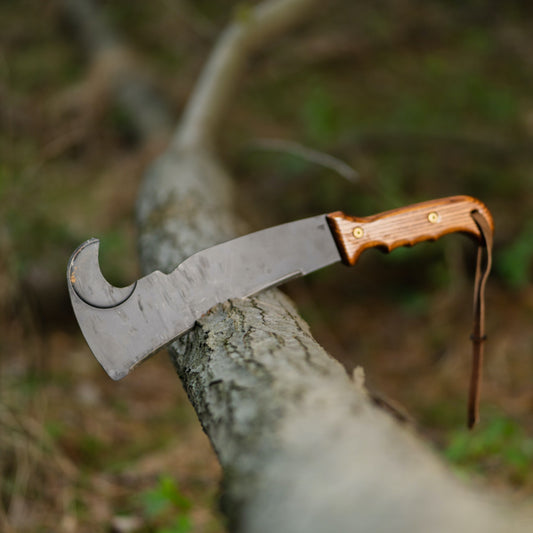Whether you're clearing a trail, harvesting wild game, or navigating the backcountry, having the right blade can make all the difference. Two of the most common bladed tools, the machete and the knife, each serve unique roles in the outdoors, survival situations, and tactical use.
But how do you know which one is right for you?
This guide examines the differences between a machete and a knife, breaks down their ideal uses, and helps you make an informed decision for your next adventure. Plus, we’ll introduce a third option that combines the strengths of both: the Woodman’s Pal.
What Is the Main Difference Between a Machete and a Knife?
The biggest difference between a machete and a knife lies in blade length, weight, and functionality. Machetes are typically long, heavy-duty blades built for chopping and slashing. They range from 12” to 24” in length and are designed to cut through thick vegetation, brush, and even small trees.
Knives, by contrast, are shorter and lighter, optimized for tasks that require precision, control, and agility. They’re better suited for carving, skinning game, food prep, and self-defense in tight quarters. Knives are also easier to carry and conceal, making them a common everyday tool.
When Is a Machete the Better Tool?
If your goal is to cut through dense foliage, clear trails, or build shelter, a machete is the obvious choice. The long blade gives you the leverage and reach you need to deal with tough, overgrown terrain.
In wilderness settings, land management, or farming scenarios, machetes are regularly used to:
- Clear thick brush and vines.
- Chop through woody saplings.
- Remove invasive plants or overgrowth.
- Harvest crops like sugarcane and coconuts.
- Cut firewood or kindling.
The design of the machete also allows for heavy downward chopping motions that a knife simply cannot replicate. In particular, the billhook machete, with its curved tip, excels at grabbing and cutting vegetation at the root. That makes it especially valuable for maintaining trails or managing land with minimal effort.
Can a Knife Be Used to Cut Vegetation?
A knife can cut vegetation but its effectiveness is very limited. It can handle light trimming, garden weeding, and small stems or vines, especially in tight quarters where a larger blade might be too cumbersome. Knives work well for precise pruning, removing growth from confined areas, or harvesting delicate plants. However, they lack the weight and reach to clear brush effectively or to take on thicker woody stems.
So, while a knife may do the job in small doses, it’s not a substitute for the cutting power of a machete when you’re facing dense vegetation or outdoor projects on a larger scale.
Is a Machete Good for Skinning Game?
While machetes are not traditionally used for skinning, certain styles can be adapted for that purpose. A shorter Bowie-style machete, for example, features a pointed tip and a sharpened edge that can handle light skinning duties in a pinch. This can be helpful if you're packing light and only want to carry one tool into the wild.
That said, using a machete for skinning is more of a backup option than a best practice. The larger blade makes precision cuts more difficult, and the lack of a refined point makes it harder to work around bone and tissue without damaging meat or hides.
If you're an experienced hunter, you know how important it is to have the right tool for field dressing. And in most cases, that tool is a well-sharpened knife.
Why Is a Knife Better for Harvesting Wildlife?
Knives are ideal for skinning, gutting, and processing game because they offer the control and sharpness needed for delicate cuts. Their compact size allows you to work around joints and bones with finesse. A knife’s pointed tip is crucial for tasks like piercing hide or starting an initial incision.
When you're out in the field, your knife becomes a precision instrument, not just a cutting tool. It’s the difference between a clean harvest and a messy one especially when you're working with small- to medium-sized game like deer, rabbits, or wild birds.
If your main purpose is food prep in the field, always pack a high-quality, fixed-blade hunting knife. But if you’re looking for a hybrid tool that can clear brush and still handle hunting prep and basic field dressing, a shorter Bowie machete or the Woodman’s Pal could give you the versatility you need.
Can You Use a Machete or Knife for Self-Defense?
Bladed tools have always had a place in self-defense. While today's primary defense tools might include firearms or pepper spray, knives and machetes are still used around the world for protection.
A machete offers intimidating reach and stopping power, making it a formidable defensive tool in open environments. Its long blade gives you the ability to keep threats at a distance, and the weight behind each swing can be devastating.
However, that reach comes with tradeoffs. In tight spaces or if an attacker closes the distance, a machete becomes more awkward to wield. The long blade can be harder to maneuver in confined areas like tents, vehicles, or narrow trails.
A knife, on the other hand, is made for close-quarters defense. It’s easier to carry, quicker to draw, and more agile in tight spaces. That makes it a popular option for those who value portability and speed.
Regardless of which you choose, remember that self-defense is about preparation, not provocation. Blades should be seen as last-resort tools, not primary weapons. Still, if you're planning to be in remote areas or unfamiliar terrain, it’s wise to carry a reliable cutting tool that can serve multiple roles, including defense if absolutely necessary.
Is There a Blade That Combines the Strengths of a Knife and a Machete?
Yes. That blade is the Woodman’s Pal survival machete.
The Woodman’s Pal was designed during World War II as a rugged survival tool for the U.S. military. Today, it remains a favorite among homesteaders, bushcrafters, landowners, and survivalists alike.
With a compact 10.5” blade, hooked tip, and balanced handle, the Woodman’s Pal is capable of:
- Clearing dense vegetation.
- Cutting small trees or saplings.
- Notching, trimming, and splitting wood.
- Field dressing and light skinning.
- Striking for self-defense if necessary.
Its size makes it more maneuverable than a machete, yet it packs more power and functionality than a standard knife. In other words, the Woodman’s Pal is the ultimate all-in-one survival blade.
Should You Choose a Machete or a Knife for Outdoor Use?
It depends on your environment, the tasks you expect to perform, and your personal preferences.
If you’ll be hacking through dense undergrowth, building a trail, or working with heavy vegetation, go with a machete.
If you plan to hunt, field dress wild game, or work with fine materials, a knife is better suited to your needs.
If you're looking for a versatile survival tool that can do a little bit of everything from clearing brush to trimming, notching, cutting, and light skinning, then the Woodman’s Pal is your best bet.
No matter what you choose, remember that your blade is only as good as your ability to use it. Practice with your tools, keep them sharp, and always handle them with respect.
Crafted with high-carbon steel and built to military specifications, the original, American-made Woodman’s Pal is a durable, field-tested tool trusted by generations of outdoorsmen, foresters, and adventurers.
Whether you're heading out for a weekend camping trip or preparing for off-grid living, the Woodman’s Pal offers the power of a machete and the precision of a knife in a single, balanced tool.
Shop now and discover why the Woodman’s Pal is one of the popular machetes for outdoor adventures.


